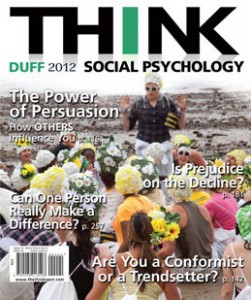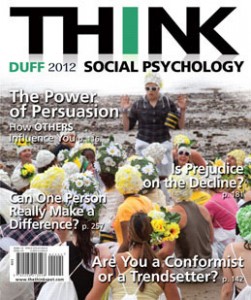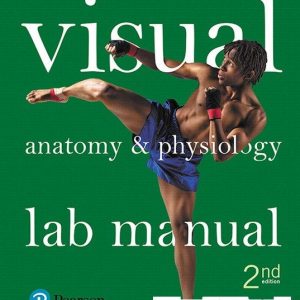Instant download Test Bank for THINK Social Psychology 2012 Edition: Duff pdf docx epub after payment.

THINK Social Psychology
Chapter 1: What is Social Psychology?
Multiple Choice Questions
- Which of the following is described by your textbook as one of the main facets of social psychology?
- Social perception
- Social influence
- Social interaction
- Social perception, social influence, and social interaction are all main facets of social psychology.
Answer: d
Page ref: 4
Skill: Factual
Easy
- _____________ is the process through which other people affect an individual’s thoughts or actions.
- Social interaction
- Social perception
- Social influence
- Social awareness
Answer: c
Page ref: 4
Skill: Factual
Easy
- _____________ is the process through which individuals form impressions of others and interpret information about them.
- Social interaction
- Social perception
- Social influence
- Social awareness
Answer: b
Page ref: 4
Skill: Factual
Easy
- A social psychologist would be most likely to study which of the following?
- Societal based problems such as deviance and crime
- How personality characteristics like introversion predict behavior
- The social factors that influence how high school students choose their college major
- They would be equally likely to study all of the above.
Answer: c
Page ref: 4
Skill: Applied
Difficult
- Meredith studies patterns of crime rates among different societies over time. Meredith is most likely a ____________.
- personality psychologist
- social psychologist
- sociologist
- cognitive psychologist
Answer: c
Page ref: 4
Skill: Applied
Moderate
- Social psychology focuses more on _________________ than personality psychology.
- inner thoughts
- personality differences
- individual traits
- situational factors
Answer: d
Page ref: 4
Skill: Conceptual
Easy
- Which of the following statements best characterizes the overlap between personality and social psychology?
- Both emphasize the study of group differences.
- Both emphasize the study of group processes.
- Both are concerned with the behaviors, thoughts, and feelings of individuals.
- Both are concerned only with private internal functioning.
Answer: c
Page ref: 5
Skill: Conceptual
Moderate
- In 1898, _____________ conducted what is considered one of the earliest formal studies in social psychology.
- Max Ringelmann
- Norman Triplett
- Gordan Allport
- Richard LaPiere
Answer: b
Page ref: 5
Skill: Factual
Easy
- _____________ is defined as the enhancement of a well-learned performance when another person is present.
- Confirmation bias
- Social facilitation
- Social perception
- Social loafing
Answer: b
Page ref: 6
Skill: Factual
Easy
- Norman Triplett conducted a study measuring the performance of children playing a simple game either alone or in the presence of another child. Triplett’s results indicated that:
- Children playing the game in pairs performed equal to children playing alone.
- Children playing the game in pairs performed better than children playing alone.
- Children playing the game alone performed better than children playing in pairs.
- Older children playing the game performed better irrespective of whether they were alone or with another child.
Answer: b
Page ref: 6
Skill: Factual
Difficult
- You are a very fast swimmer but you always perform better during competitions than during practice. This phenomenon refers to:
- Social facilitation
- Confirmation bias
- Social perception
- Social loafing
Answer: a
Page ref: 6
Skill: Applied
Moderate
- Chris works at a local coffee shop on the weekends. After the manager leaves for the night, he and his fellow employees are required to clean the tables and floors before closing. Often Chris does not put forth a strong effort to make sure he does his part and instead relies on his co-workers to do most of the cleaning. Chris is engaging in which of the following?
- Social loafing
- Social facilitation
- Confirmation bias
- Hindsight bias
Answer: a
Page ref: 6
Skill: Applied
Moderate
- According to your textbook, which of the following was argued to be a major milestone in the development of social psychology curriculum?
- World War I
- The formation of the Society for the Psychological Study of Social Issues (SPSSI)
- The publishing of textbooks on social psychology
- The creation of social-psychological journals such as Basic and Applied Social Psychology
Answer: c
Page ref: 6
Skill: Factual
Moderate
- A professor has decided to assign group projects to his class. In order to avoid the phenomenon of social loafing, the professor might do which of the following?
- Assign every student the same grade no matter what.
- Do not assign any grades at all.
- Grade each person separately based on the specific part of the project they completed.
- Make the group as big as possible.
Answer: c
Page ref: 6-7
Skill: Conceptual
Difficult
- Which of the following statements best represents a conclusion you could draw from LaPiere’s landmark study on the relationship between people’s attitudes and their behaviors?
- Attitudes do not always predict behaviors.
- Behaviors always predict attitudes.
- Attitudes always predict behaviors.
- There is nothing we can conclude about the relationship between attitudes and behaviors.
Answer: a
Page ref: 6
Skill: Conceptual
Difficult
- Which of the following represents a major factor in determining whether social loafing occurs instead of social facilitation?
- Intelligence
- Accountability
- Personality
- Task difficulty
Answer: b
Page ref: 7
Skill: Conceptual
Moderate
- The phenomenon of social loafing is diminished under which of the following conditions?
- When the task is easy
- When the task is important
- When the task is unimportant
- When there are a lot of people performing the task
Answer: b
Page ref: 7
Skill: Conceptual
Moderate
- Edwin Ross and William McDougall are important figures in the history of social psychology. What important contribution did they make to the development of social psychology?
- Together they developed the Society for the Psychological Study of Social Issues (SPSSI).
- They each established modern journals in the field of social psychology.
- Together they created the Journal of Social Issues.
- They each published one of the first textbooks in social psychology.
Answer: d
Page ref: 7
Skill: Factual
Easy
- What is considered the quintessential reference guide for the field of social psychology?
- Handbook of Social Psychology
- Society for the Psychological Study of Social Issues (SPSSI)
- The Journal of Social Issues
- Journal of Applied Social Psychology
Answer: a
Page ref: 7
Skill: Factual
Easy
- Which of the following statements about the Society for the Psychological Study of Social Issues (SPSSI) is most true?
- SPSSI was created by Edward Ross and William McDougall.
- SPSSI was created to bring together socially minded psychologists interested in applying social psychology to social issues and public policy.
- SPSSI was created to bring together social psychologists who studied basic research.
- SPSSI was created to promote the overlap between personality and social psychology.
Answer: b
Page ref: 7
Skill: Conceptual
Easy
- According to your text, how did the focus of Floyd Allport’s work in social psychology differ from the focus of William McDougall’s work?
- Floyd Allport’s work focused on the role of external influences on behavior.
- Floyd Allport’s work focused on ‘instinct’ as the main drive of behavior.
- William McDougall’s work focused heavily on experimental studies.
- William McDougall’s work focused on the role of external influences on behavior.
Answer: a
Page ref: 7
Skill: Conceptual
Difficult
- John is studying the research question “when and why do people conform to a group’s behavior?” This would fall under which main facet of social psychology?
- Social perception
- Social cognition
- Social interaction
- Social influence
Answer: d
Page ref: 8
Skill: Applied
Difficult
- Basic and Applied Social psychology, Social Psychology Quarterly, and Social Cognition are examples of _____________.
- Handbooks in the field of social psychology
- Books in the field of social psychology
- Journals in the field of social psychology
- Magazines dedicated to social psychology
Answer: c
Page ref: 8
Skill: Factual
Easy
- Which of the following events had a major impact on the development and direction of social psychology?
- World War I
- The Great Depression
- World war II and the Nazis’ occupation of Europe
- The Civil Rights movement
Answer: c
Page ref: 8
Skill: Factual
Easy
- In a 1979 article for Social Psychology Quarterly, who did Cartwright name as the one person who has had the greatest impact on the field of social psychology?
- Adolf Hitler
- Solomon Asch
- Gordon Allport
- Kurt Lewin
Answer: a
Page ref: 8
Skill: Factual
Moderate
- You are conducting research on helping behavior. You theorize that helping a person in an emergency is impacted by how noticeable the situation is as well as by individual differences in compassion for others. Which of the following best captures the perspective you are taking on this research topic?
- Cognitive perspective
- Cultural
- Interactionist
- Social
Answer: c
Page ref: 8
Skill: Applied
Difficult
- Who pioneered a perspective that involved combining internal factors from personality psychology and external factors from social psychology?
- Leon Festinger
- Kurt Lewin
- Solomon Asch
- Floyd Allport
Answer: b
Page ref: 8
Skill: Factual
Moderate
- The interactionist perspective involves the combination of ____________________.
- biological factors and cognitive factors
- internal factors (from personality psychology) and external factors (from social psychology)
- basic and applied research
- pure and applied research
Answer: b
Page ref: 8
Skill: Factual
Easy
- Social comparison theory and cognitive dissonance theory were developed by which of the following social psychologists?
- Stanley Milgram
- Solomon Asch
- Leon Festinger
- Kurt Lewin
Answer: c
Page ref: 9
Skill: Factual
Moderate
- Who is considered the father of modern social psychology?
- Norman Triplett
- Fritz Heider
- Solomon Asch
- Kurt Lewin
Answer: d
Page ref: 9
Skill: Factual
Easy
- Rachel is interested in conducting research on the fundamental ideas behind behavior and cognition, such as how individuals form stereotypes. Her research is best described as:
- Action research
- Applied research
- Basic research
- Rachel’s research can be described as both action research and applied research
Answer: c
Page ref: 9
Skill: Applied
Moderate
- _______________ refers to the illusion that a stationary pinpoint of light in a dark room appears to move and was used in research conducted by _______________.
- Autokinetic effect; Muzafer Sherif
- False consensus effect; Muzafer Sherif
- Autokinetic effect; Gordan Allport
- False consensus effect; Gordan Allport
Answer: a
Page ref: 9
Skill: Factual
Moderate
- Erin is conducting research on how to improve recycling behavior in suburban towns. This type of research is best described as _______________.
- Theoretical research
- Applied research
- Pure research
- Basic research
Answer: b
Page ref: 9
Skill: Applied
Difficult
- A researcher is interested in understanding what makes an individual aggressive towards another person. This type of research is best described as _______________.
- action research
- applied research
- basic research
- either action research or applied research
Answer: c
Page ref: 9
Skill: Applied
Difficult
- According to your textbook, the use of laboratory research was a source of debate among some researchers. What was a main criticism of this type of research?
- It was too time consuming.
- It was too artificial.
- It was too difficult.
- It did not answer interesting questions.
Answer: b
Page ref: 9
Skill: Conceptual
Moderate
- According to your textbook, what took place during the 1970s and 1980s that had a strong impact on the discipline of psychology, including social psychology?
- A cognitive revolution
- A behaviorist revolution
- A personality revolution
- Both a behaviorist and personality revolution
Answer: a
Page ref: 10
Skill: Factual
Moderate
- Which of the following statements about social psychology is most true?
- Social psychology is only concerned with private internal functioning.
- Social psychology is not concerned with an individual’s thoughts and behaviors.
- Social psychology is an extremely old discipline.
- Social psychology is primarily considered to be a Western-dominated discipline.
Answer: d
Page ref: 10
Skill: Conceptual
Moderate
- During the 1990s, which of the following became a research topic of greater interest to social psychologists?
- The role of biology
- The role of personality traits
- The role of culture
- The role of cognition
Answer: c
Page ref: 10
Skill: Factual
Moderate
- Children in the blue eye/brown eye experiment, described in the beginning of the chapter, demonstrated prejudice as a result of influence from their teacher as well as from the intolerant culture in which they lived. Which of the following perspectives best highlights the influence from both the immediate environment and society?
- Social cognitive perspective
- Evolutionary perspective
- Social learning perspective
- Sociocultural perspective
Answer: d
Page ref: 10
Skill: Conceptual
Moderate
- John is interested in how different parental disciplinary tactics affect children’s behavior and how this varies by culture. John is approaching his research from which social psychological perspective?
- Sociocultural perspective
- Evolutionary perspective
- Social learning perspective
- Social cognitive perspective
Answer: a
Page ref: 10
Skill: Applied
Difficult
- ______________ is a perspective that focuses on the physical and biological predispositions that result in human survival.
- Sociocultural perspective
- Evolutionary perspective
- Social learning perspective
- Social cognitive perspective
Answer: b
Page ref: 10
Skill: Factual
Easy
- A parent hits a child for misbehaving and then later on that child hits his sibling for breaking a toy. Assuming the child hit his sibling because he was imitating his parent’s behavior, this would be an example of ______________.
- Evolutionary learning
- Natural selection
- Observational learning
- Cognitive learning
Answer: c
Page ref: 11
Skill: Applied
Moderate
- A social psychologist argues that people today tend to live in groups and organized societies because it has aided in our ancestors’ survival and as such has become commonplace. This illustrates what type of perspective?
- A sociocultural perspective
- A social learning perspective
- A social cognitive perspective
- A evolutionary perspective
Answer: d
Page ref: 11
Skill: Applied
Difficult
- ________________ is a process by which individuals with certain characteristics are more frequently represented in subsequent generations as a result of being better adapted to their environments.
- Sociocultural selection
- Natural selection
- Social-family selection
- Kin selection
Answer: b
Page ref: 11
Skill: Factual
Easy
- What is argued to be a key theory to many of social psychology’s core concepts?
- Social loafing theory
- The theory of natural selection
- Social facilitation theory
- Social learning theory
Answer: d
Page ref: 11
Skill: Factual
Moderate
- The social cognitive perspective differs from the social learning perspective in what primary way?
- The social cognitive perspective emphasizes the role of individual thoughts.
- The social cognitive perspective emphasizes the role of biology.
- The social cognitive perspective emphasizes the role of the environment.
- The social cognitive perspective emphasizes the role of culture.
Answer: a
Page ref: 11
Skill: Conceptual
Difficult
- If you study how students’ academic performance is affected by teachers praise and punishment, you would most likely be approaching your research from which of the following perspectives?
- Sociocultural perspective
- Evolutionary perspective
- Social learning perspective
- Social cognitive perspective
Answer: c
Page ref: 11
Skill: Applied
Moderate
- Which of the following statements is most true concerning social psychology’s relationship to other disciplines?
- Social psychology can help answer research questions relevant to economists but not business leaders.
- Social psychology has little utility for other disciplines and social psychologists primarily work alone.
- Social psychology can help researchers in many other disciplines and the possibilities for interacting with other areas are abundant.
- Social psychology is not relevant to other disciples because it focuses too much on the role of social factors.
Answer: c
Page ref: 11-12
Skill: Conceptual
Easy
- In Asch’s class studies on conformity, he had some individuals who were part of the research team provide answers that were incorrect even when the correct answer was obvious. These individuals are known in research as _____________.
- Liars
- Accomplices
- Co-conspirators
- Confederates
Answer: d
Page ref: 12
Skill: Factual
Moderate
- ____________is an emerging field that integrates the study of physiological mechanisms with social psychological perspectives.
- Physiological psychology
- Social neuroscience
- Social interaction
- Social perception
Answer: b
Page ref: 12
Skill: Factual
Moderate
- A researcher wants to conduct a study exploring how college students interact with opposite sex students compared with same sex students. In order to observe these interactions, you instruct individuals who are part of the research team to sit with real research participants and ask them questions. The students who were placed in the study to play a particular role for a researcher are known as _______________.
- Confederates
- Accomplices
- Co-conspirators
- Liars
Answer: a
Page ref: 12
Skill: Applied
Easy
- Based on research presented in your textbook, which of the following statements is most true concerning the study of attraction?
- Married couples who have different personality traits are more likely to report that they are satisfied in their relationship compared with couples who have similar personality traits.
- Married couples are likely to have different religious beliefs compared with randomly paired couples.
- Opposites attract.
- Married couples are more likely to be similar in terms of their values compared with randomly paired couples.
Answer: d
Page ref: 12
Skill: Factual
Difficult
- Some of the conclusions drawn by researchers’ studies in social psychology may seem obvious. However, as your textbook author points out, many of our common beliefs have been disproven by social psychologists. What is one reason why we may assume that social psychology is common sense?
- Because research proves that most of our common sense beliefs are true
- Because the subject matter of social psychology often seems familiar and personal and we believe we are naturally knowledgeable about human behavior
- Because most of social psychology is indeed common sense
- Because common sense is easy to prove without doing research
Answer: b
Page ref: 12
Skill: Conceptual
Easy
- Matthew interviews for an important job but the company ultimately decides to select someone else for the position. Matthew thinks to himself, “I knew the interview went poorly and I wasn’t going to get the job!” Matthew’s belief that he knew the outcome all along is an example of what phenomenon?
- Hindsight bias
- False consensus effect
- Optimistic bias
- False uniqueness effect
Answer: a
Page ref: 12
Skill: Applied
Easy
- The tendency to think you knew something would occur all along is known as ____________.
- Optimistic bias
- False consensus effect
- Hindsight bias
- False uniqueness effect
Answer: c
Page ref: 12-13
Skill: Factual
Easy
- Joseph sees money fall out of a stranger’s pocket and returns it to the rightful owner. He believes it would be dishonorable to keep money that is not his own and assumes that most others share this view. Which of the following may explain why Joseph could be incorrect in his assumption?
- Joseph is failing to notice information that confirms his belief.
- Joseph is not spending enough time thinking about his own views.
- Joseph is not considering that others may have a different idea of what it means to be dishonorable.
- Joseph is not incorrect in his assumption.
Answer: c
Page ref: 13
Skill: Applied
Difficult
- According to your textbook, the false consensus effect is likely to increase under which of the following situations?
- When the situation is very clear
- When the situation permits differential construal
- When everyone shares the same opinion
- When the situation is very simple and straightforward
Answer: b
Page ref: 13
Skill: Conceptual
Easy
- Ruth is taking a social psychology class with a professor who has a reputation of being mean and unhelpful. Ruth notices that the professor will not provide any extensions for late work or provide any extra credit opportunities for students struggling with the coursework. However, Ruth fails to consider that the professor offers review sessions prior to examinations and responds to all email questions within a 24 hour time period. By noticing information that confirms her belief that the professor is unhelpful and ignoring information that disconfirms her belief, Ruth is engaging in what social psychological phenomenon?
- The false consensus effect
- The false uniqueness effect
- The hindsight bias
- The confirmation bias
Answer: d
Page ref: 13
Skill: Applied
Moderate
- Which of the following is used by members of the scientific community to minimize bias and reduce errors?
- The scientific method
- Differential construal
- The confirmation bias
- None of the above
Answer: a
Page ref: 13
Skill: Conceptual
Easy
- ________________ is defined as an approach to thinking that involves using systematic observations, measurements, and experiments to assess information.
- Hindsight bias
- Differential construal
- The scientific method
- The confirmation bias
Answer: c
Page ref: 13
Skill: Factual
Easy
True/False Questions
- A social psychologist’s main focus is on group behavior at the societal level. T F
Answer: False
Page ref: 4
Skill: Conceptual
- Social perception is the process through which other people affect an individual’s T F
thoughts or actions.
Answer: False
Page ref: 4
Skill: Factual
- A manager who wants to avoid social loafing in her office should make each T F
employee’s performance individually identifiable.
Answer: True
Page ref: 6
Skill: Applied
- Marc’s ability to throw a football farther when his friends are watching than when T F
he is alone describes the phenomenon of social loafing.
Answer: False
Page ref: 6
Skill: Applied
- Social loafing is reduced when a task is perceived as important to an individual. T F
Answer: True
Page ref: 7
Skill: Conceptual
- The Society for the Psychological Study of Social Issues (SPSSI) was created primarily T F
to focus research efforts on basic cognitive and social processes.
Answer: False
Page ref: 7
Skill: Conceptual
- World War II is an event identified as having changed the structure and direction of T F
social psychology.
Answer: True
Page ref: 8
Skill: Factual
- A perspective that considers both individual characteristics and social factors is best T F
considered a personality perspective.
Answer: False
Page ref: 8
Skill: Factual
- Social psychology is generally considered a Western-dominated discipline. T F
Answer: True
Page ref: 10
Skill: Factual
- The sociocultural perspective focuses on the relationship between social behavior T F
and culture.
Answer: True
Page ref: 10
Skill: Factual
- The belief that humans help one another because helping behavior evolved to aid T F
in our ancestor’s survival is an sociocultural perspective.
Answer: False
Page ref: 11
Skill: Factual
- Confederates are the participants taking part in the study T F
Answer: False
Page ref: 12
Skill: Factual
- Social psychologists use common sense to determine answers to their research T F
questions.
Answer: False
Page ref: 12
Skill: Conceptual
- Christy’s assumption that she knew all along that the United States was going to be T F
attacked by terrorists on September 11th is an example of hindsight bias.
Answer: True
Page ref: 12
Skill: Applied
- Your belief that most other people feel as negatively about abortion protestors T F
as you do reflects the phenomenon of the false consensus effect.
Answer: True
Page ref: 13
Skill: Applied
- Utilizing the scientific method is one way social psychologists can minimize bias in T F
their research.
Answer: True
Page ref: 13
Skill: Conceptual
Short Answer Questions
- Define social psychology and describe how it differs from the discipline of sociology.
Page ref: 4
Skill: Factual
- Name the 3 main facets of social psychology. Briefly define 1 of these 3 facets.
Page ref: 4
Skill: Factual
- Briefly compare and contrast social psychology with personality psychology.
Page ref: 4
Skill: Conceptual
- Name two research topics that would fall under the rubric of ‘social influence’. Why would they be considered examples of research topics in the area of social influence?
Page ref: 4; 8
Skill: Applied
- Serena always plays her violin better in front of an audience than during her practice sessions. Identify and define this phenomenon.
Page ref: 6
Skill: Applied
- Distinguish between social loafing and social facilitation. Name one factor that can diminish the likelihood that social loafing will occur.
Page ref: 7
Skill: Conceptual
- Describe the purpose of the Society for the Psychological Study of Social Issues (SPSSI) and explain how it has had a significant impact on the discipline of psychology and society as a whole.
Page ref: 7
Skill: Conceptual
- Compare and contrast two different perspectives of social psychology.
Page ref: 10-11
Skill: Factual
- Consider the behavior of ‘cheating on a test’. Describe how a researcher taking an evolutionary perspective would explain this behavior compared with a researcher taking a social learning perspective.
Page ref: 10-11
Skill: Applied
- Define the hindsight bias and provide an example.
Page ref: 12
Skill: Factual
- Your textbook author suggested that children in the blue eye/brown eye experiment showed prejudice that was influenced by their teacher and classmates as well as by their surrounding culture. Which social psychology perspective best captures these findings? Why is this perspective important?
Page ref: 13
Skill: Applied
- Explain the relevance of ‘differential construal’ to the false consensus effect. Be sure to define the false consensus effect in your answer.
Page ref: 13
Skill: Conceptual
- What is the confirmation bias? Provide an example.
Page ref: 13
Skill: Factual
Essay Questions
- Name two individuals who have had a significant impact on the field of social psychology and describe their contribution.
Page ref: 6-7
Skill: Factual
- You and your colleagues are asked to write a joint report and submit it to your boss. You end up doing less work than the rest of the team because you know that your boss will not be able to identify who contributed more or less to the final product. Name and define the phenomenon illustrated in this example. What could your boss do to avoid this problem for future group tasks?
Page ref: 6
Skill: Applied
- Describe how findings from Norman Triplett’s work illustrating social facilitation were at odds with findings from Max Ringlemann’s work on social loafing. Explain what accounted for these different findings.
Page ref: 6
Skill: Conceptual
- Describe Richard LaPiere’s landmark study of the discrepancies between individuals’ attitudes and behavior. Based on his findings, what can you conclude about the relationship between a person’s attitude and his or her behavior?
Page ref: 6
Skill: Conceptual
- Explain how and why World War II had such a significant impact on the structure and direction of social psychology.
Page ref: 8
Skill: Conceptual
- As your textbook author states, “social psychologists do not work alone in their field”. Describe how research conducted by social psychologists might be useful in other disciplines. Provide a specific example.
Page ref: 11-12
Skill: Applied
- Why is it the case that social psychology seems, at times, to be all common sense? Using research evidence presented in your textbook, provide an example of how the commonsense adage ‘opposites attract’ has not been supported by social psychological work. Why is it problematic to rely on common sense to understand and predict behavior?
Page ref: 12
Skill: Conceptual
- How can biases such as the hindsight bias or the confirmation bias negatively affect a social psychologist’s work? What can social psychologists do to avoid these types of biases?
Page ref: 12
Skill: Conceptual





